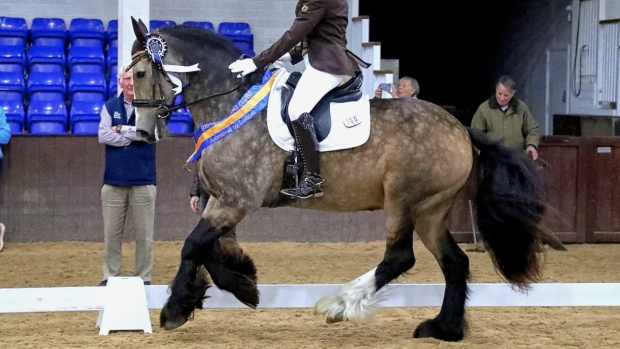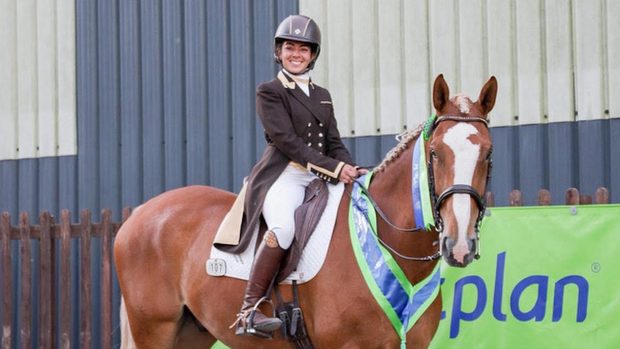Freestyle dressage is booming – and you don’t need to be a music whizz or have a fancy app to get involved. Here’s how to create your own dressage freestyle, from picking a soundtrack to building a floor plan that fits your horse.
“We’ve seen a huge increase at the grassroots level – it’s not something to be scared of,” says Tony Hobden of Equidance. “Freestyle should feel less daunting than straight dressage – nobody knows where you’re going!”
 Watch the video
Watch the videoGetting started is now easier than ever. Riders competing at novice silver and above can qualify for the freestyle winter regionals simply by riding in regular British Dressage (BD) tests – making it more accessible than ever to earn a place at the NAF Five Star Winter Championships each April.
In the summer, freestyle classes are open from prelim bronze to inter I, with riders qualifying for the Petplan Summer Freestyle Area Festivals and championships in October.
Para riders can also qualify for the Equissage Pulse Para Freestyle to Music Championships by scoring 63% or above in their respective section.
Yet, despite growing opportunities, many riders hesitate – often put off by music licensing, editing challenges or the cost of professional help. But putting a freestyle together doesn’t have to be complicated or expensive.
How to create a dressage freestyle
Yorkshire-based amateur Rachel Platt choreographed her own freestyle using free software like Audacity.
“I’m a musician, so people probably assume that’s why I can put routines together,” Rachel explains. “But in reality, I’m more of a practical, working musician – I’m no technical whizz at all.
“You definitely don’t need to be a musician to create freestyles. Plenty of people who aren’t musical but spend more time on computers than I do would probably find the software easier to use than me.
“I just Googled anything I couldn’t figure out, and the answers were right there – it wasn’t rocket science at all. It’s really just cut and paste, drag and drop.
“I wish I’d done it earlier, to be honest. I think the first routine I made was at advanced medium, by which time you’ve already got a lot of moves you have to fit in. Whereas if I’d started at prelim, I think the learning process of getting to grips with the logistics like the floorplan would have been easier.”
For those who’d rather leave the music editing to the experts, professional help is more affordable than you might expect. At Equidance, prices start at £129 for prelim-level tests, rising to £389 for grand prix.
“We use the same software as the mainstream music industry, so everything sounds really polished,” says Tony. “But I’ve never wanted costs to be prohibitive. What I really want is for more people to get involved and have fun with music.”
Tony’s “magic triangle” and top tips for picking music
Tony recommends choosing tracks based on three pillars:
-
It suits your horse
-
You love it
-
Judges don’t hate it
“Even though the judging shouldn’t be about personal preference,” he says, “but if you’ve got something you hate being blared out after you’ve been sitting in a stuffy box for hours, it’s hard to ignore.”
There is no specific rule that prohibits the use of vocals within the music. “You can have singing as long as it doesn’t distract too much from the performance,” Tony says, “like Celine Dion belting out My Heart Will Go On at the top of her voice during the walk.
“But hitting a chorus as you come out of the corner and into a medium or extended movement can be fabulous.”
BD’s guidelines reward riders who create a cohesive theme with music that clearly defines the beginning, middle, and end.
“This means your music should be from the same genre,” Tony explains. “You can’t have, for example, Lady Gaga for your trot, Mozart for the walk and ACDC for the canter – the music needs to build a narrative.
“That’s why film soundtracks are always a big winner for me because they’re designed to fit a storyline and are often played with an orchestra, but it’s more hybrid than classical – so it might be mixed with some synthetic drums that you can use to match the footfall and tempo of the movement, which is an important thing to get right.”
Licensing made simple
Music licensing puts many riders off, but it doesn’t need to.
“If you’re riding under BD rules, you’re covered for music use as long as it’s on the Phonographic Performance Ltd [PPL] database, provided you’re not planning on reselling it,” says Tony.
To register your music, download a music license record form and sub-licence agreement from the BD website. Submit them by email or post before your competition.
“One mistake I made in the beginning was that I found some music that I really liked and set my heart on it but then actually realised I wasn’t able to use it because it wasn’t on the PPL website,” Rachel warns. “Now I always check first – the search tool is simple.”
She also likes using karaoke versions: “You still get the energy of vocals, but they’re less overpowering – often just backing vocals or chorus lines.”
Practical tips to get started
-
Use free software like Audacity – beginner-friendly and plenty of YouTube tutorials.
-
Don’t overcomplicate your floorplan – “At lower levels, focus on flow,” Tony recommends. “Showcase your horse’s strengths without making it too difficult.”
-
Watch other people’s tests – “The Area Festivals are fantastic for this,” Rachel says. “You’ll quickly pick up what works – and what doesn’t.”
-
Use BD templates – free floorplan guides are on the BD site
Tony’s final advice? Whether you’re making it yourself or using a professional, just give it a go!
- To stay up to date with all the breaking news from major shows throughout 2025, subscribe to the Horse & Hound website
You may also be interested in:

Fancy trying affiliated dressage, but not quite sure where to start? You need to read this…

‘I challenge you not to love it’: what working equitation is and why you should give it a go

Your guide to the Petplan Area Festivals, including how to qualify for this championship dressage series

Subscribe to Horse & Hound magazine today – and enjoy unlimited website access all year round




